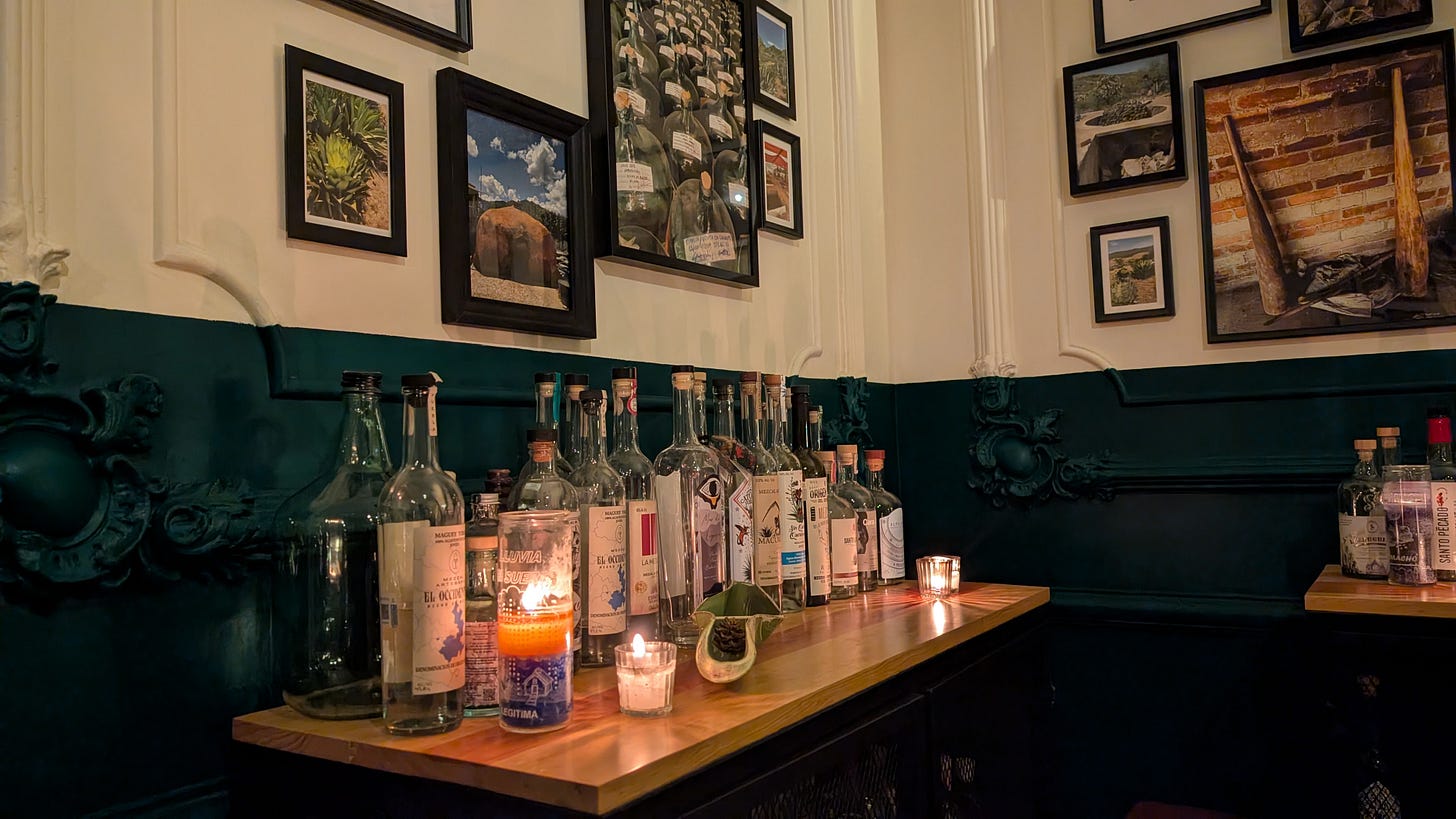Mezcal Was Never Meant to Behave
A beginner’s guide to the spirit with ancient roots that survived outlaw status and bureaucracy, not to mention most of human history — and still tastes like tradition, terroir, and a tiny kiss.
If someone once handed you a glass of mezcal and said, “It’s like tequila but smokier,” bless their heart—but they left out most of the story. Mezcal is not just a spirit—its proof that flavor can outlast empire. From colonial bans to modern red tape, mezcaleros have kept the fire alive—crafting wild, smoky, small-batch agave spirits by hand, despite generations of being pushed out, priced out, or nearly erased. If you’re here because you searched types of mezcal, how to drink mezcal, what is Pechuga, or how to find a good bottle—welcome. You’ve just stumbled into the rabbit hole (yes, those 400 rabbits).
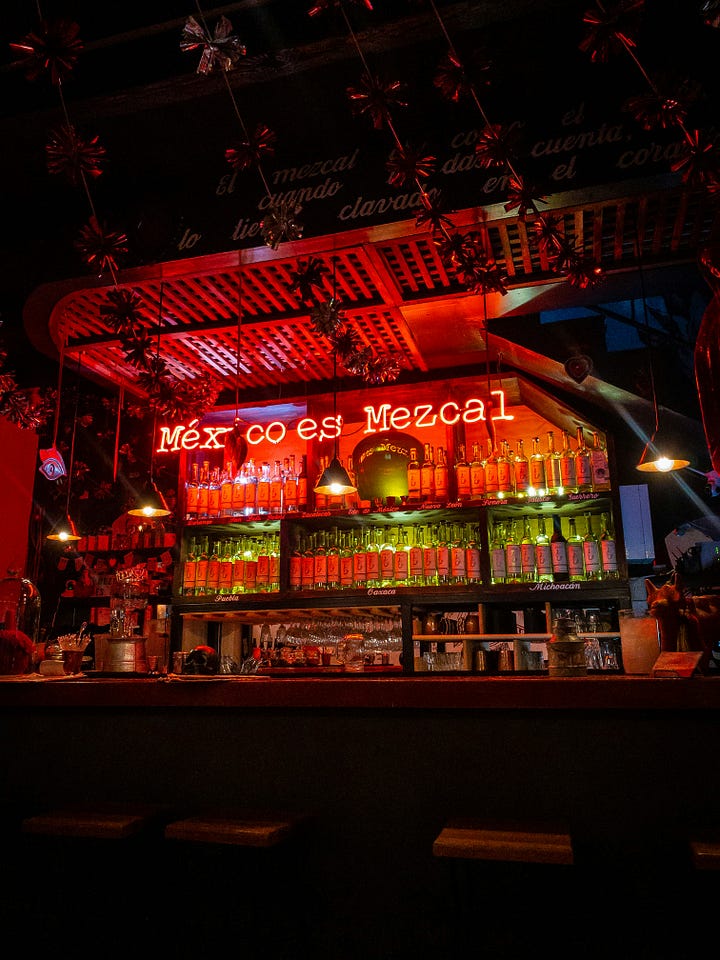
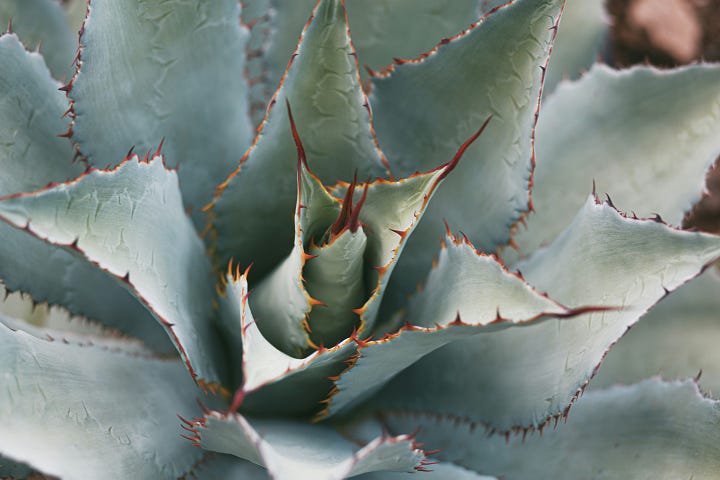
Real mezcal isn’t a party trick. It’s not just for cocktails or wild nights out (though no judgment if that’s how you met). It’s a slow-crafted, deeply regional, fiercely personal spirit made from roasted agave (aka maguey)—fermented and distilled by hand, often by the same families for generations. It can taste like roasted fruit, clean smoke, minerality, or bubblegum and black pepper had a baby on a volcano.
This post is your soft landing into the good stuff: what mezcal is, how mezcal is made (spoiler: pit ovens and sometimes horses), how to read the label, how to drink mezcal the traditional way (in besitos, or tiny kisses), and how to find a bottle you’ll actually like—from Espadín to Tepeztate, and artesanal to ancestral. This guide is your crash course in everything that makes mezcal wild, weird, and wonderful.
So grab a glass, slow down, and give it a kiss. This isn’t just a drink—it’s a story older than cities, rooted in ritual, shaped by fire, microbes, and memory. Whether you’re mezcal-curious or ready to level up your sipping game, we’ve got you.
Hey food friends! 👋 I’m Kaitlynn, half of a food-loving couple 🍜 exploring DC (& beyond) who knows the best connections happen at a shared table 🍽️. Whether you're searching for the perfect bánh mì or trying to master your grandma's marinara 🍅, I’m here with dishes (and discussions) that make life more interesting. Come hungry, leave inspired. ✨🍴
Flavors of Mexico City: A series on the Dishes, History & Where to Eat
Mexico City is layered—historically, culturally, and even literally. From the ancient markets of the Mexica people (often called the Aztecs) to Spanish colonial plazas to today’s bustling street stalls, bakeries, and world-class restaurants, its food scene is built on centuries of cultural fusion, migration, and reinvention.
This is a culture that gave the world tacos, chocolate, AND vanilla—just to name a few. Whether you’re planning a visit, looking for inspiration in your own kitchen, or just hungry to understand the soul of CDMX, this series is your guide.
We’re diving into the real stories behind the food, uncovering the flavors that define the city, and sharing practical tips for finding (or making) something incredible to eat. From tacos to coffee and pan dulce to mezcal, Mexico City’s food story is as rich as it gets—and we’re just getting started.
So What Is Mezcal, Really?
Let’s get one thing clear from the start: tequila isn’t mezcal’s cooler cousin—it’s actually mezcal’s straight-laced offspring.
That’s right. Tequila is a type of mezcal. Always has been. But somewhere along the way, mezcal stayed wild while tequila got a PR team.
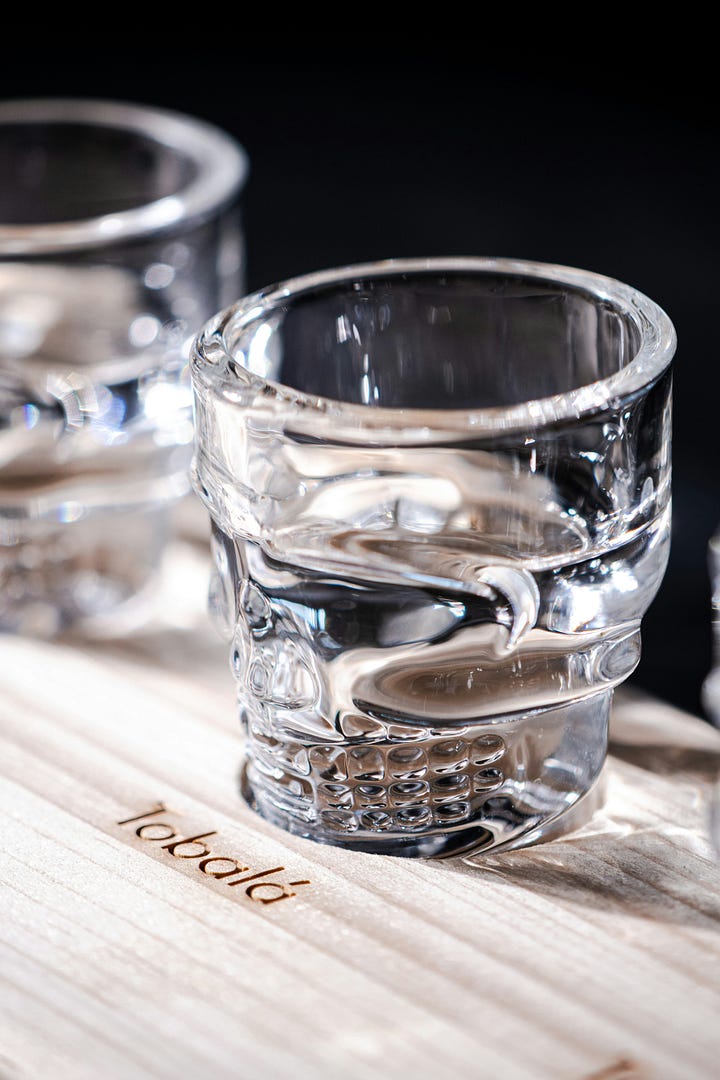
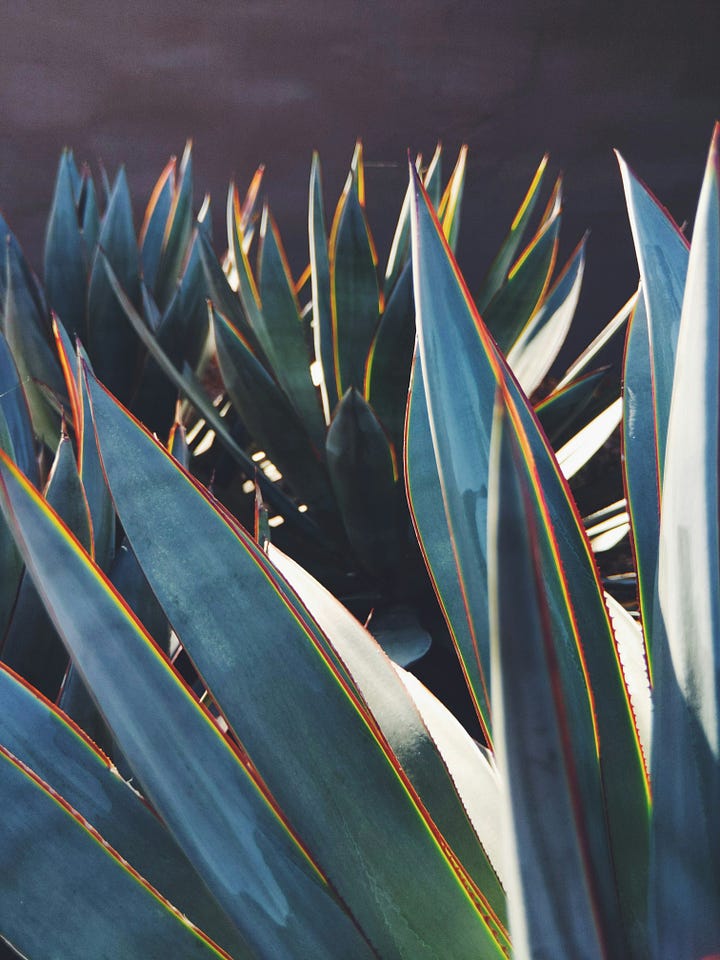
Mezcal overall is older, deeper, and—dare I say—way more interesting. The name comes from metl and ixcalli in Nahuatl, meaning “cooked agave.” And that’s exactly what it is: agave, roasted low and slow in underground pits, then fermented and distilled into something smoky, sacred, and strong. It’s made from dozens of agave species—some cultivated, many wild. Some take 30 years to mature before harvest. (Name another drink that waits three decades to even get started. I’ll wait.)
This isn’t a trend. Indigenous peoples in Mesoamerica have used agave for more than 8,000 years—as food, fiber, fuel, medicine, and yes, for fermentation. Pulque (a lightly fermented agave drink) possibly predates wine and beer. Agave was so central to life, people named gods after it. And still today, you’ll hear: “Para todo mal, mezcal… y para todo bien, también.” For everything bad, mezcal. For everything good? Mezcal too.
As for distillation: there’s some debate about whether it existed in pre-colonial times. But most likely, the technique arrived with Filipino or Chinese traders in the 1500s. Either way, the mezcal we know today emerged in rural communities—cooked in pit ovens, fermented in wooden vats, distilled in clay or copper pots, and passed down through generations.
When the Spanish showed up, they banned native spirits to boost their own imports. So mezcal went underground—literally. It was made quietly, in secret, for centuries. Even when mezcal became legal again in 1980, the hurdles didn’t stop. The Mexican government soon created the Consejo Regulador del Mezcal (CRM), which certifies producers under a denominación de origen—similar to how Champagne or Parmigiano Reggiano are regulated. Under these rules, capital-M 'Mezcal' must follow strict guidelines around geography, agave type, and production method, and can only be made in nine states.
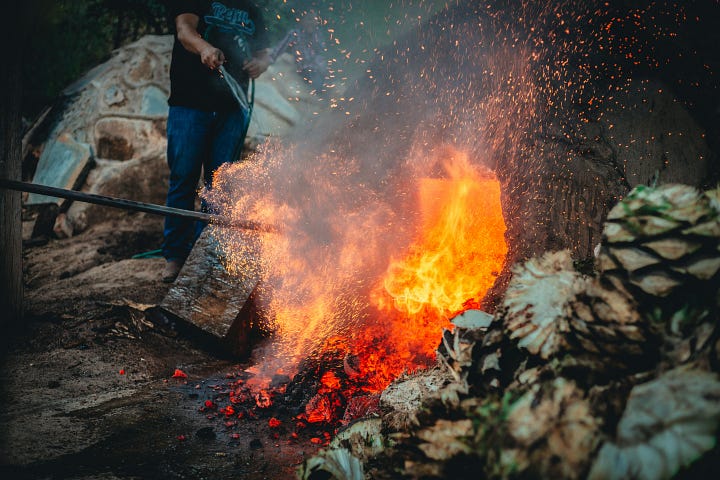
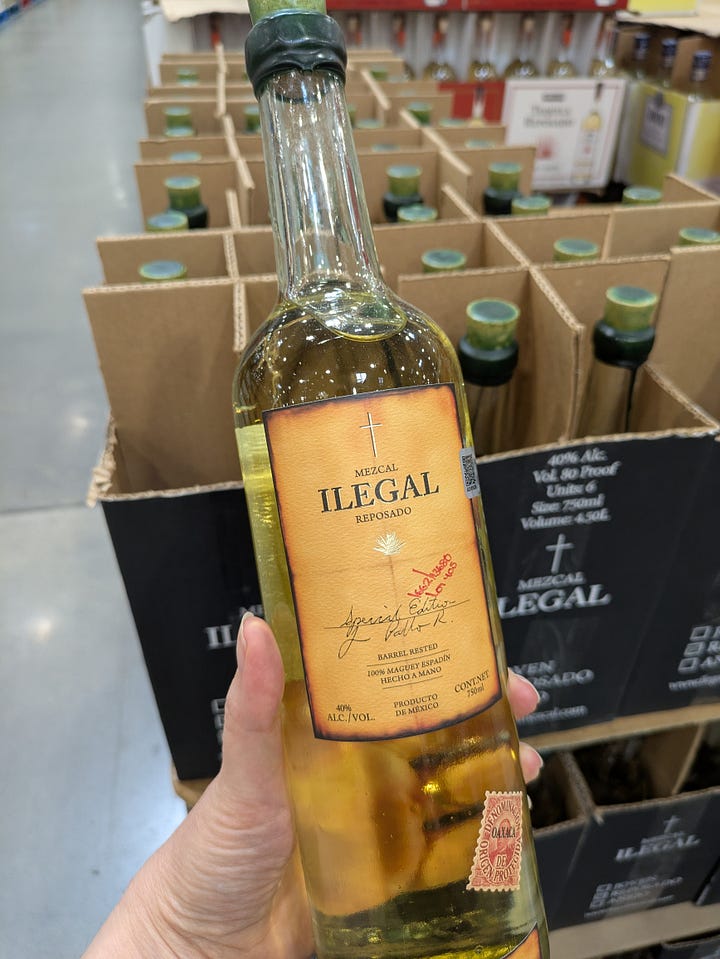
But here’s the kicker: some of the most respected mezcaleros now reject certification altogether. They argue the CRM’s rules often benefit industrial producers and sideline smaller, traditional makers with fees, red tape, and rigid criteria that don't reflect how mezcal has been made for generations. Brands like Illegal Mezcal wear the outlaw history like a badge and others like Cinco Sentidos take it a step further and refuse certification as a form of protest—and they’re thriving anyway. Their bottles show up in curated shops all over the world and yes, even at Costco in Washington DC. Call it rebellion. Call it integrity. Either way, it’s working.
So no, not all mezcal is capital-M 'Mezcal.' That term means it’s certified by the CRM. But many traditional, small-batch spirits—true to ancestral methods—skip certification by choice or necessity. Lowercase 'mezcal' may only say ‘destilado de agave’ (distilled from agave), but carry centuries of knowledge and culture. Both can be delicious—but they’re not legally interchangeable.
Meanwhile, agave spirits are popping up in places like Australia, Israel, South Africa, and the U.S. Southwest. And while that experimentation is fascinating, real mezcal still begins in Mexico’s volcanic soil, shaped by fire, air, time, and tradition.
And if that first glass hits you just right? The Aztecs might say you’ve met one of the 400 conejos—mischievous rabbit spirits who rule over all the different types of drunkenness. (More on them soon. Buckle up.)
How Tequila Got Famous
By now, you might be wondering: “Wait—so why is tequila in every bar, and mezcal still feels like a secret?”
Timing. Tequila became the face of agave spirits not because it was the best—but because it was ready. During U.S. Prohibition in the 1920s, Americans went south looking for legal-ish booze. Tequila was fast to produce, easy to standardize—made from just one agave (blue Weber) mostly in or near the town of “Tequila” in Jalisco. It traveled well—and the world was thirsty.
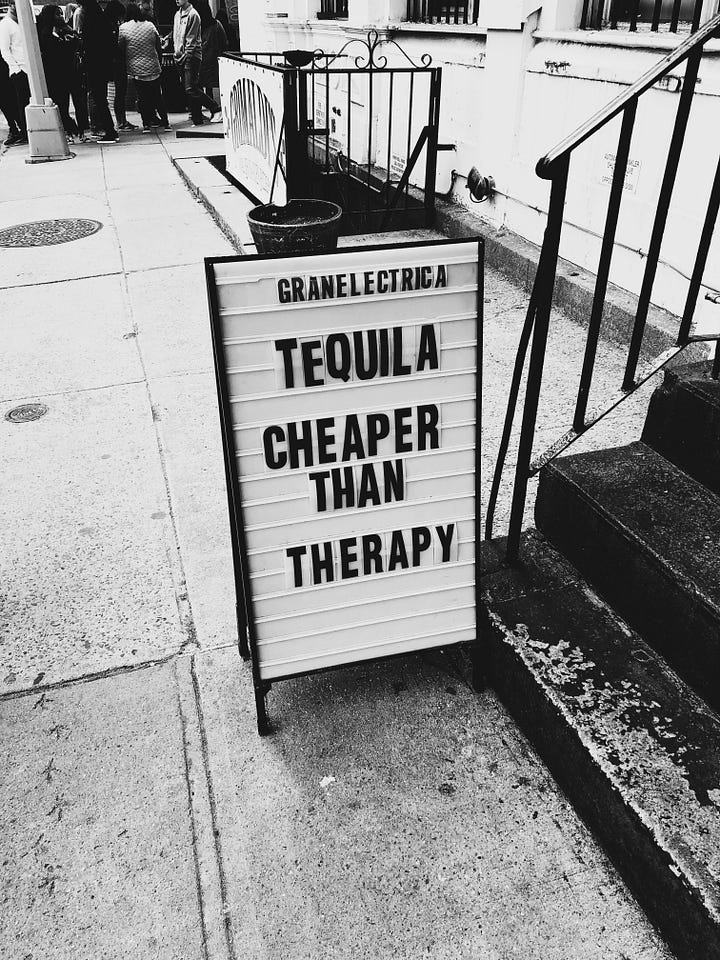
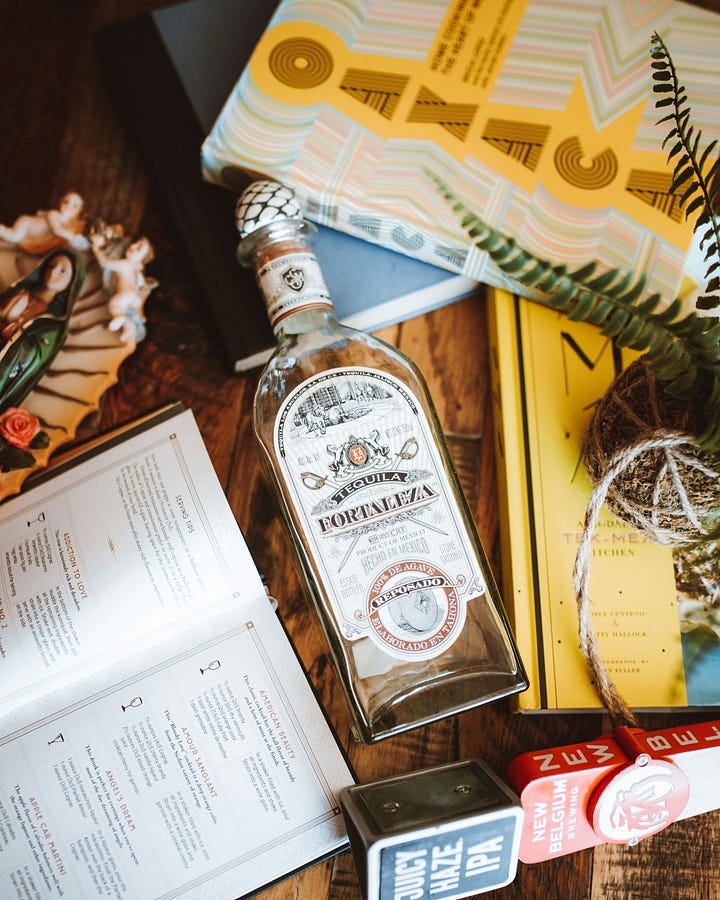
Mezcal? Not so much. That wildchild took its sweet time. It still does. Slow-roasting agaves in underground pits, fermenting with wild yeasts, distilling in small family palenques across rugged terrain. Great for flavor, terrible for export. Tequila got the spotlight. Mezcal stayed in the shadows (but the good kind, with firelight and singing).
Tequila’s glow-up really kicked in during the 1940s and ’50s, when the margarita craze hit U.S. bars and Hollywood made tequila look like a vacation in a glass. Smart branding, consistent product, and slick packaging did the rest.
Tequila actually got so popular that other countries started making similar spirits and calling them Tequila, so in 1974 the Mexican government set up what may be the first denominación de origen outside of Europe to protect it’s production the same way the production of Champagne is handled in France.
To keep up with global demand, many large-scale tequila brands began blending in additives—things like caramel color, flavoring agents, and sweeteners. Not always a problem, but worth knowing. There are actually no legal regulations preventing Tequila makers from having only 51% agave and 49% additives, unless they say something like ‘100%’ agave (or tequila). Mezcal, for now, remains mostly small-batch and additive-free. That makes it harder to scale, and harder to fake. And while that’s kept it under the radar, it’s also preserved its depth, variety, and roots in tradition.
Tequila got mass appeal. Mezcal stayed personal. Both can be great—you just have to know what you’re sipping.
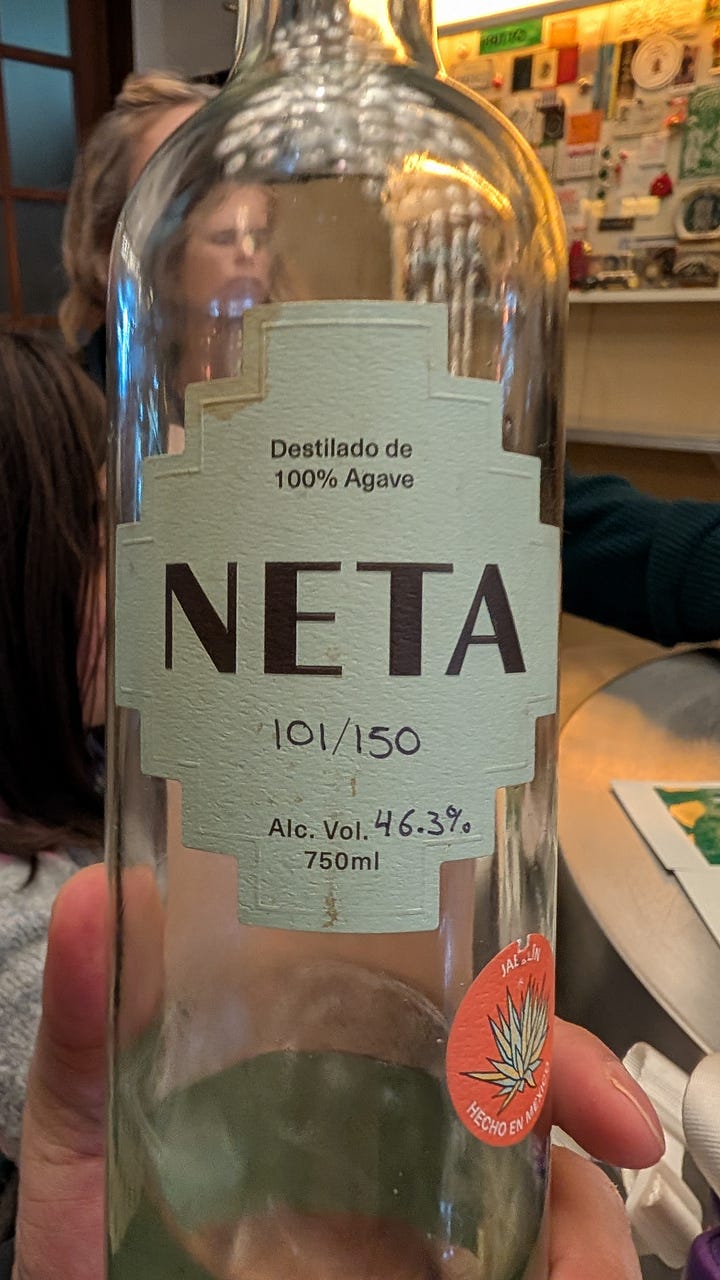
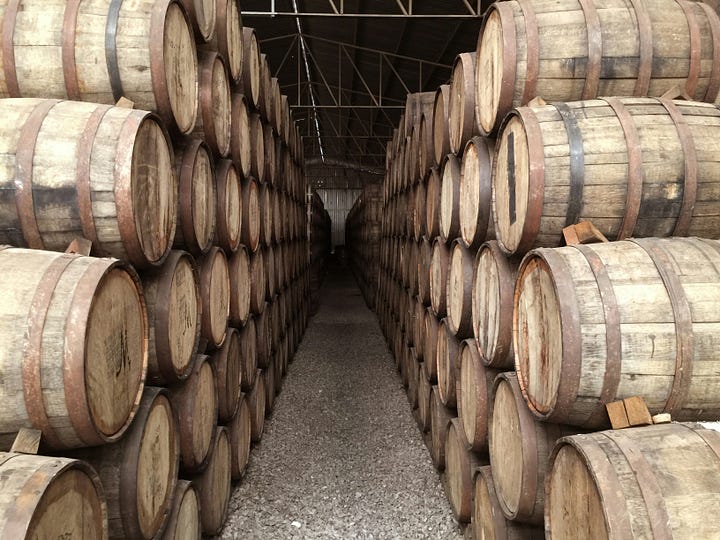
Oh, and that brownish hue many folks associate with tequila? It’s not usually the natural color. That started during Prohibition too, when tequila was aged in leftover whiskey barrels for transport. Most agave spirits come off the still clear. Unless it’s añejo or reposado (aged in barrels), that caramel hue? It’s mostly marketing.
Today, mezcal is finally catching up—not in volume, but in curiosity. Because while tequila is predictable, mezcal stayed local, handmade, and super variable—no two batches are quite the same. Which made it harder to brand… but way more interesting to drink.
How Mezcal is Made Artisanally
Making mezcal is not for the impatient. Or the easily distracted. Or anyone who doesn’t enjoy smelling like roasted agave for a week straight.
Luckily, some folks live for it.
There are many variations on the process, but here’s the breakdown from El Buho, one of the brands preserving one relatively representative example traditional production methods used for hundreds of years:
Harvest ripe agave, ideally when it’s just starting to flower (called the quiote) but before it shoots up so that all the minerals and nutrients are still concentrated in the agave heart. It’s like catching a fruit at the exact second it’s ripe.
Cook the hearts (piñas) underground over oak for a week. Yes, actual earth ovens. Yes, their ancestors would be proud.
Mash with a massive stone wheel pulled by a literal family horse.
Ferment in open pine vats using wild yeast from the air and well water. No shortcuts, just science and serendipity.
Distill twice in copper pot stills. First run includes the agave fibers (bagasso), second run doesn’t.
Bottle it by hand in glass flasks, often after 4-6 months rest in stainless tanks. Minimal aging, maximum character.
Every single choice—from soil to microbe to flame, even the microflora in the air—is wildly specific to place. You can’t fully control it. You can only guide it. A mezcal made in one valley won’t taste like its neighbor. It’s an ecosystem in a bottle.
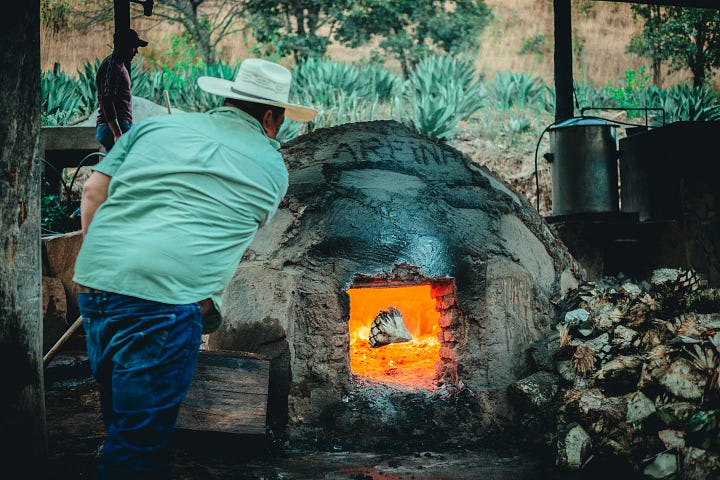
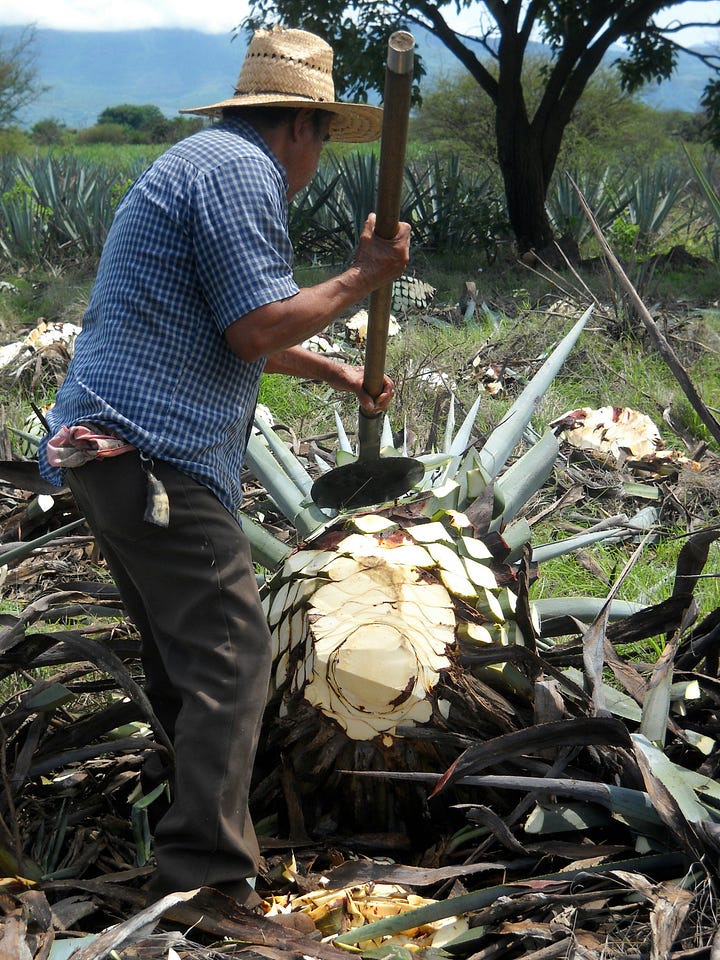
This isn’t factory work. It’s craft. Not because it’s trendy, but because it’s how it’s always been done. Fermented agave drinks like pulque have been made for millennia and used in everything from medicine to celebration. Mezcal is just one chapter in that story—still handmade, still hyper-local, still changing slightly with every batch.
Mezcal Is A Living System
Mezcal production is tied to biodiversity in a big way. When you drink mezcal, you’re not just sipping booze. You’re drinking years—sometimes decades—of biological patience, cultural memory, and ecological coordination.
Agave takes years to grow—sometimes decades. And unlike wine grapes or grain, agave doesn’t give you a second harvest. Once harvested, it doesn’t grow back. That’s it. One plant, one chance. So how you farm agave really matters.
Here’s where it gets tricky. As demand for mezcal exploded (up from under 1 million liters a year to over 8 million by the 2020s), some producers started using naturally occurring cloned agaves—hijuelos—instead of letting plants go to seed. Faster, yes. But also risky. It’s like replanting your garden using only one cousin’s DNA over and over and wondering why it gets sick all the time. Clone farming limits diversity, which means the plants are more vulnerable to disease, weather, and flavor monotony.
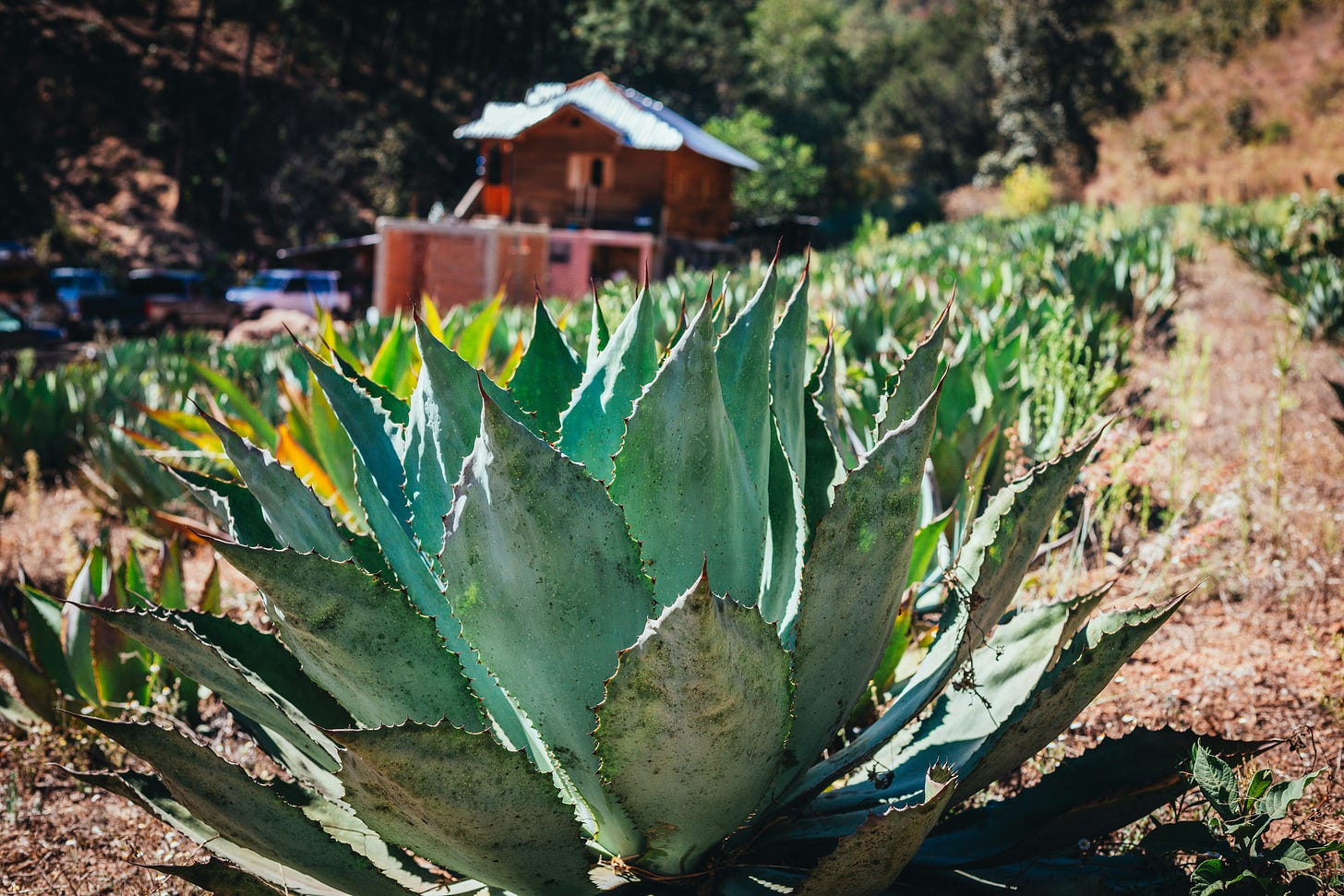
The best mezcaleros do it differently. They do use hijuelos but they also let their strongest agaves flower, attract bats and birds to spread the pollen, and grow seed-born plants. And they plant for a future they might not even get to taste. They raise those babies in nurseries for years before planting. It’s like sending your liquor’s ancestors to preschool.
It’s not just farming. It’s stewardship.
Why does this matter? Because monoculture (a.k.a. clone farming alone) kills flavor diversity, makes crops vulnerable to disease, and turns living landscapes into liquor factories. That’s how you lose not just good mezcal—but the ecosystems and families that make it.
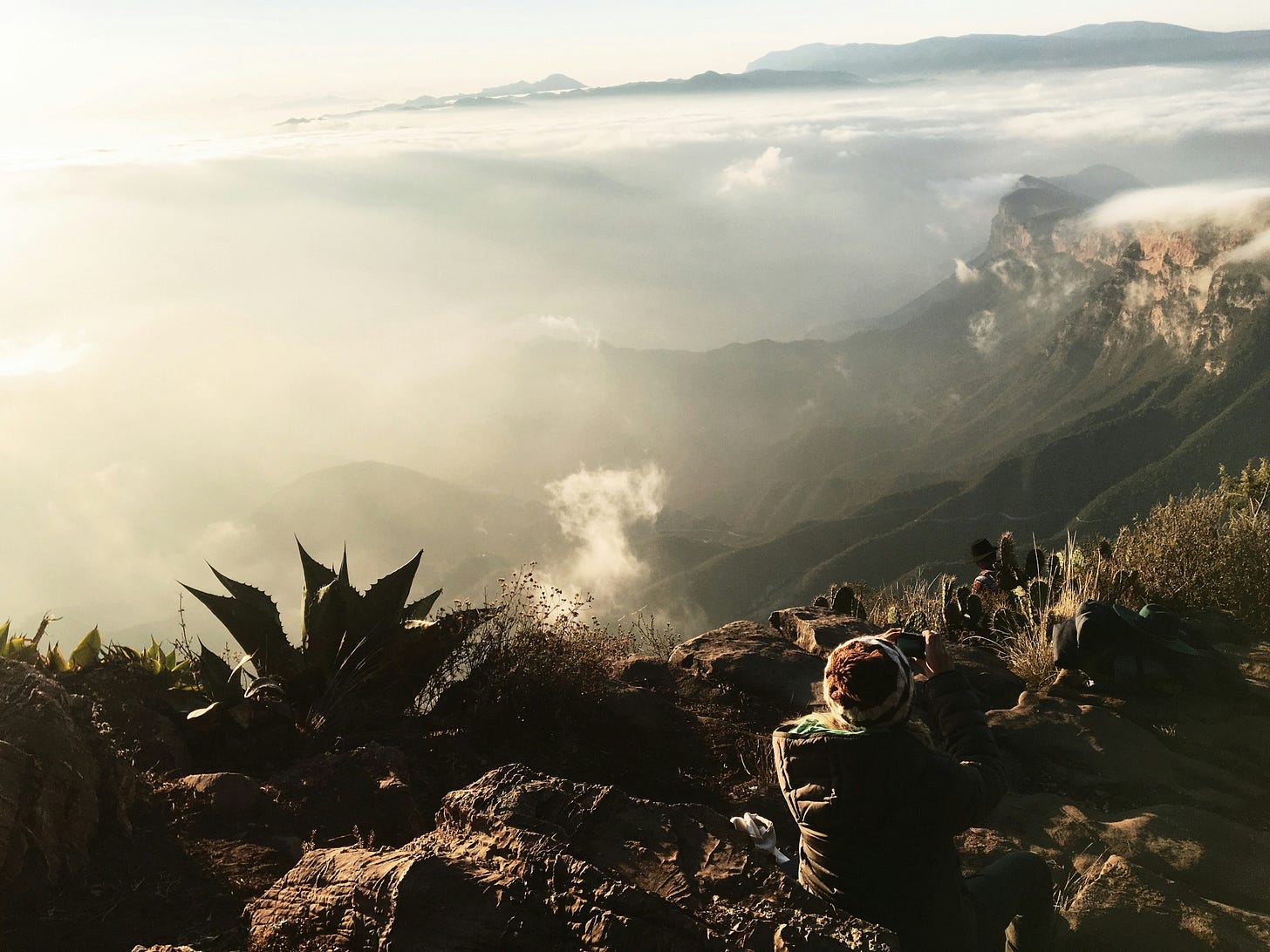
As mezcal gains international fame, more regions outside Mexico are planting agave and experimenting. But just like you can grow a tomato in Iceland, doesn’t mean you’re making marinara like your tía, not to mention mezcal is legally protected by Mexico’s CRM, and only nine states are allowed to produce certified mezcal. Other places might make agave spirits (and some are fascinating!), but they’re not the same. The culture, the microbes, the maguey—those are homegrown.
So if you’re drinking mezcal, you’re part of that chain—farmer to fermenter to firepit to glass.
If you’re starting to suspect this rabbit hole has no bottom… you’re right. For a front-row seat to the smoky, dusty, gloriously complicated world of mezcal-making, check out fellow Substacker Jonathan Lockwood’s Mezcal Maniac
He’s on the ground visiting producers, chasing stories, and capturing it all—like this chef’s kiss moment of mezcaleros trying to load massive roasted agave onto the back of a very unimpressed horse: video link.
Don’t forget to read on below for our cheat sheet on how to find a good bottle where you’re at.
How to Drink Mezcal: Little Kisses, Big Flavor
Traditionally, you drink mezcal in besitos—tiny kisses. Just enough to coat your lips or touch your tongue and wake up your senses. It’s not a sip. It’s a flirtation. No mixers, no rush. Like a hello that could turn into a whole conversation—if you let it.
Sure, you can create a cocktail or knock one back if the mood calls for it. But if you want to know mezcal? You kiss it. You slow down. You let it breathe. You let you breathe. Mezcal is like a relationship—it doesn’t tell you everything on the first date.
Wherever you are, another reason to really enjoy your mezcal because in Mexico, mezcal isn’t usually what people drink casually. Our tasting guide at Salon de Agave told us locals often drink rum—because mezcal is so heavily taxed, the good stuff is actually cheaper to ship to the U.S. than to pour at home. That’s… a little heartbreaking. But also a reminder that if you’re drinking it anywhere in the world maybe pause and appreciate every earthy, floral, bubblegummy (!) note.
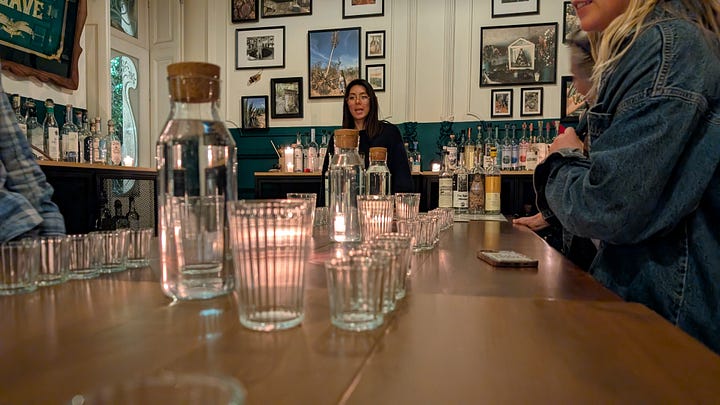
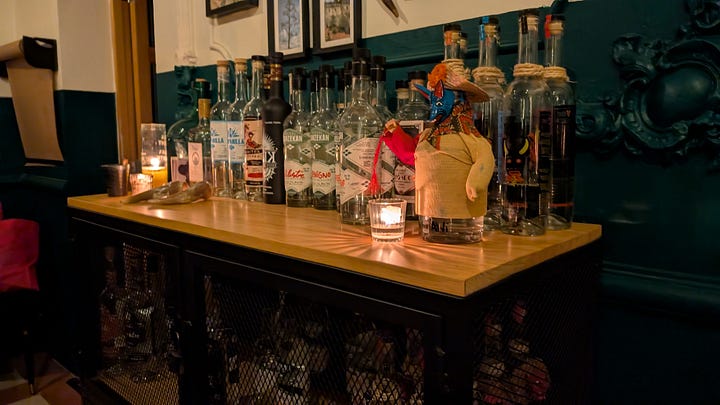
And no, that’s not a typo—some mezcales do taste like bubblegum. There is a surprisingly wide range of flavor notes due to the very wide array of differences in local production choices. Some have the taste of damp stone, cinnamon, roasted pineapple, the ghost of a campfire flirtation. If that sounds too poetic, just try it and tell me I’m wrong.
The global mezcal market has ballooned in the past decade—up more than 600% in export volume from 2011 to 2021, which means not every bottle is artisanal magic. Some are brilliant. Some are… trying. So be curious. Ask questions. Learn your labels. Most legit mezcales will say if they’re artesanal or ancestral, which tells you a lot about the process.
Still unsure? Pay attention to how it makes you feel. The Aztecs believed in the Centzon Tōtōchtin, or the “400 rabbits.” These were divine, slightly chaotic rabbit spirits—each one representing a different kind of drunkenness, from giggly to flirty to the kind that ends with you hugging a cactus. According to legend, they were born of Mayahuel (the agave goddess) and Patecatl (the god of pulque and healing). So the next time mezcal hits you funny, don’t blame your pour—blame the conejos.
🥃 Types of Mezcal & How to Find One You’ll Love
Just getting into mezcal? You don’t need to memorize every agave species to find something delicious. Here’s your mezcal cheat sheet.
🗺️ TL;DR Tasting Map:
✅ New to mezcal? Start with Espadín.
✅ Feeling fancy? Try Tobalá or Tepeztate.
✅ Like earthy flavors? Go for Karwinskii types like Tobaziche or Madrecuixe.
✅ Want something rare and dramatic? Look for Arroqueño or Cenizo.
✅ Want to trust the process? Look for “artesanal” or “ancestral” on the label.
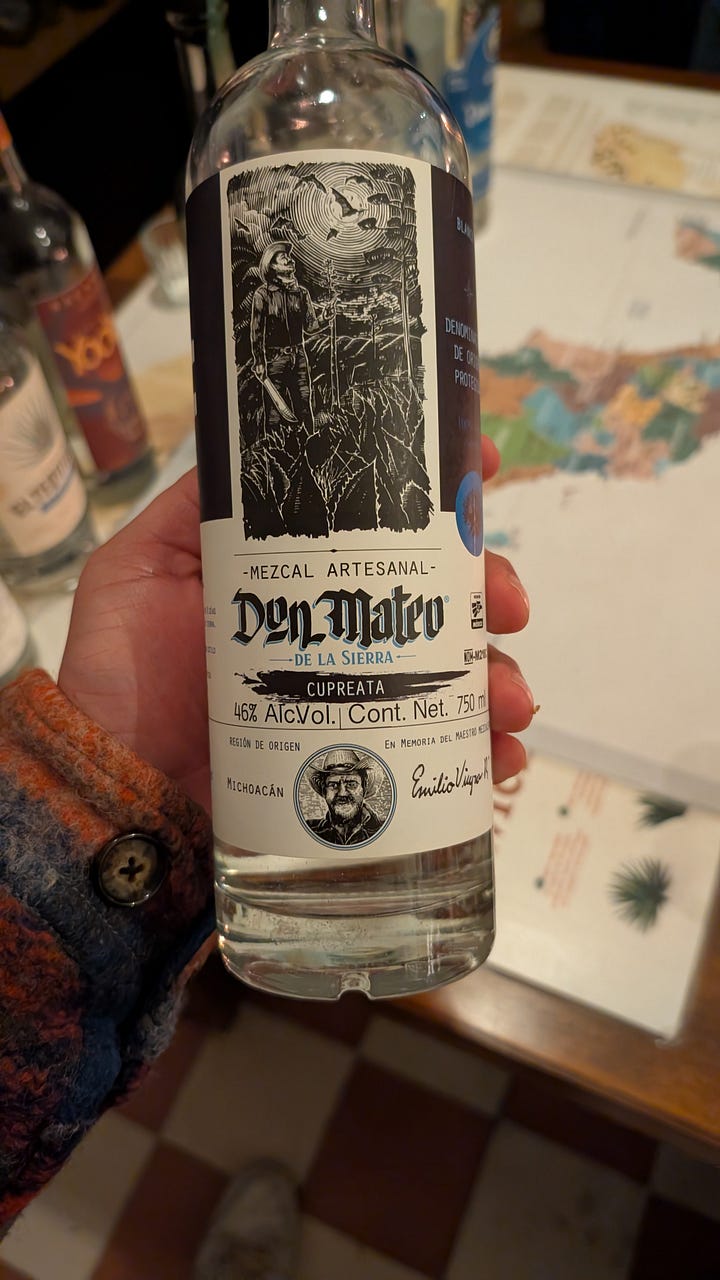
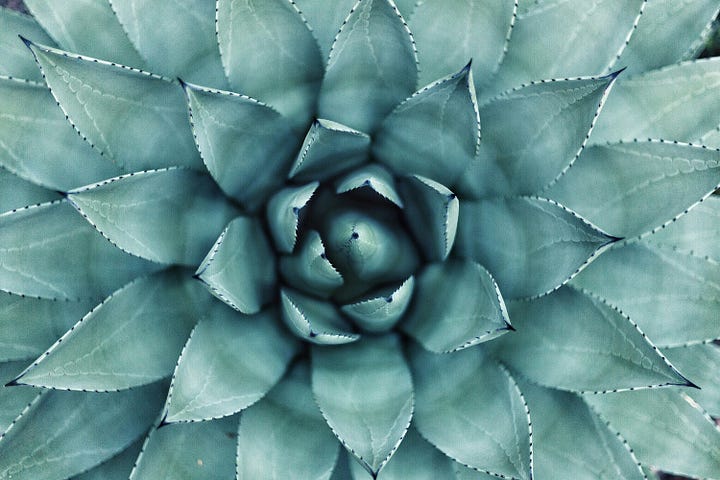
🕵️♀️ How to Spot a Good Bottle
Want the good stuff? Flip the bottle and look for:
🌍 Mezcalero name, Community or producer name (individual/town/state): These often say more than the brand. No mezcalero’s name or town or producer listed? That’s a red flag.
🌱 Agave Type (e.g., Espadín, Tobalá - detailed list below). Good bottles name the agave. Whether it’s familiar like Espadín or rare like Tepeztate, the variety hints at flavor (and cost).
🛠️ Production Style (“Artesanal,” “Ancestral”): How it was made. Artesanal uses pit ovens, wild fermenting, and copper or clay stills. Ancestral goes deeper—clay pots, no tech. Bonus green flags: “Destilado en barro” (clay) or “Madurado en vidrio” (glass-aged).
🔢 Batch Number & Alcohol Content: Small batch? Great. It means care, not mass production. ABV around 45–50% is normal. Higher proof? Just take slower besitos.
📜 Denominación de Origen (DO): Official DOs protect tradition. If it says Raicilla, Bacanora, or Sotol, it’s not mezcal—but still a regionally protected, great agave spirit.
🚩 Red Flags: If a bottle skips the basics—no agave type, no producer, no place—it’s probably made to look good, not taste great.
Thanks for being part of this table. And hey—if paid membership isn’t doable, we get it. But even a one-time donation helps keep the feast going.
The rest of the details are hard to get correct without writing a borderline encyclopedia entry so feel free to skim the next part if reading a bunch of definitions isn’t your thing.
🌱 What It’s Made From: Agave Varieties
💫 Espadín (Agave Angustifolia): The gateway agave. Most mezcal is made from Espadín. Smoky, smooth, slightly peppery—if you like tequila, start here.
🍑 Tobalá (Agave Potatorum): The wild, rare beauty. Think minerality, stone fruit, and wild sweetness. Pollinated by bats, harvested by hand.
🌾 Karwinskii Family (Tobaziche, Madrecuixe, Barril): Tall, wild, and herbaceous. Expect dry earth, herbs, a whisper of floral. Think mezcal’s forest floor notes.
🌼 Tepeztate (Agave Marmorata): The showstopper. Up to 30 years to mature. Loud, green, spicy, and dramatic—mezcal’s cologne model.
🍫 Arroqueño (Agave Americana var. oaxacensis): Big and brooding. Floral highs, chocolatey lows, and a long, smoky finish. Introspective sipping.
⛰️ Cenizo (Agave Durangensis): Cool-climate vibes. Durango-grown. Grassy, funky, sometimes strangely clean.
🌰 Cupreata (aka Chino): From Guerrero and Michoacán. Sweet, tropical fruit, melon, slight smoke.
🌄 Alto: High-altitude and variable. Often earthy or piney, with an alpine sharpness. Less common but rising.
🪨 Lamparillo: Complex minerality and a savory edge. Found in northern states. Slightly funky and rewarding.
🌵 Sotol: Mezcal-adjacent. Not mezcal technically (it’s not from agave but Dasylirio Grassy, dry, and desert-born.
🔥 How It’s Made: (a.k.a. Production Method)
Mezcal Ancestral
The oldest-school method. Pit ovens, wild fermentation (maybe in cowhide or hollow logs), and clay-pot distillation. Rare, often wild-tasting, and labor-intensive. Expect soul, smoke, and surprises.
Mezcal Artesanal
Most small brands you see will fall here. Cooked in earth pits, fermented in wood or stone, distilled in copper or clay. Balanced between tradition and scale.
Mezcal (Industrial)
Still legally mezcal, but made with high-tech tools: autoclaves, stainless steel, and column stills. Not always bad, but usually less romantic.
🐔 Bonus: Other Styles You’ll See
🥩 Pechuga: A celebration mezcal distilled with meat (yes, meat) and fruit/spices. Traditionally a chicken breast, but you’ll also see turkey, mole, or even vegan versions. Made for special occasions—not your everyday sipper.
🥂 Madurado en Vidrio (Glass-Aged): Aging without oak. The mezcal rests in glass for months or years, softening over time without changing flavor. Think of it as mellow, not woody.
🕰️ Reposado & Añejo: Barrel-aged. Añejo must be aged in a barrel for at least 1 year. Softer, sweeter, and more like what whiskey drinkers may expect. Some folks love the rounder vanilla notes; others think it masks the magic. Worth trying—but maybe after your besitos phase.
💫 Blanco: Aged in glass bottles. Keeps its clear coloring.
Where to find good mezcal
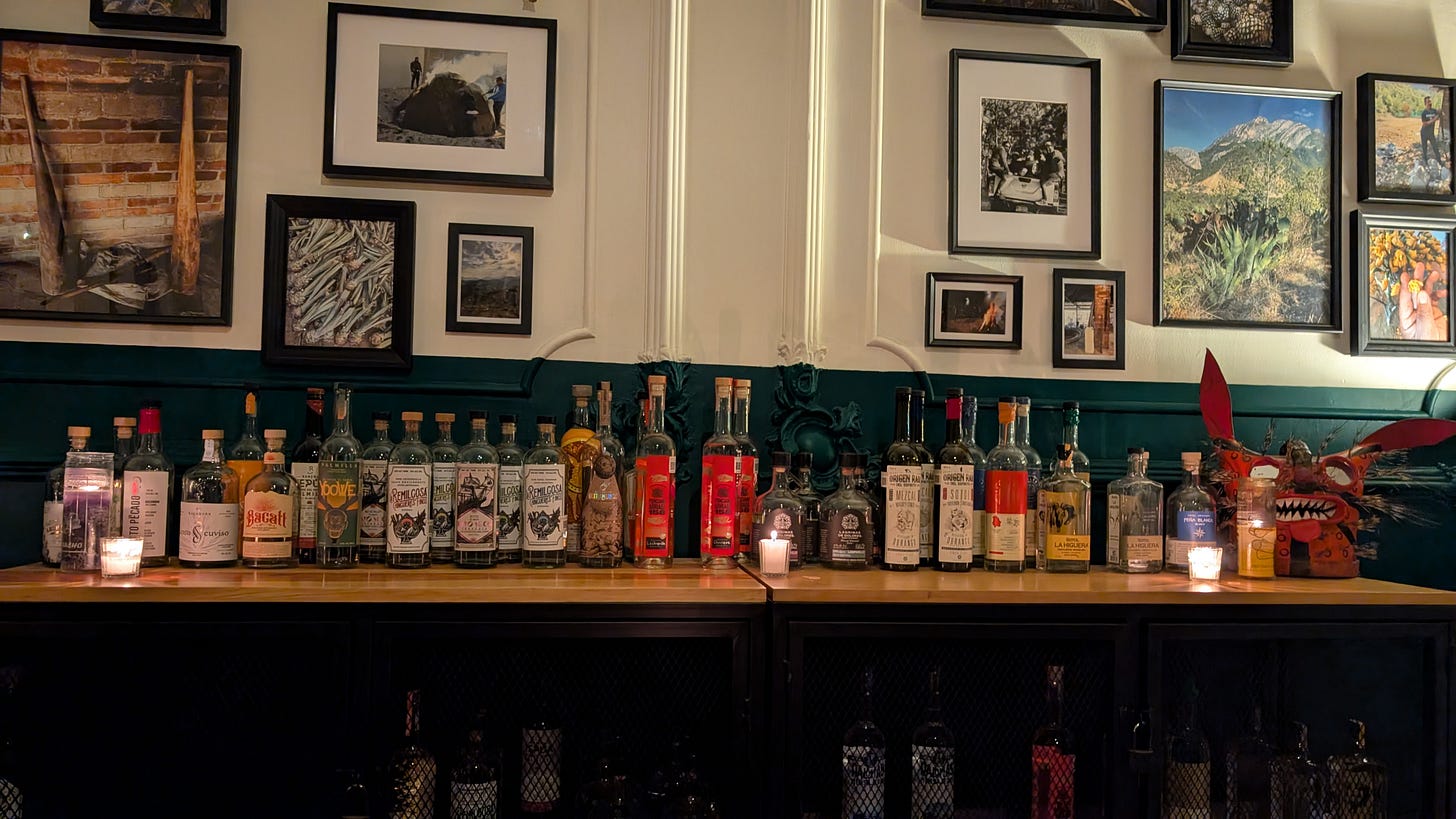
In Mexico City
🍸 Salon de Agave – Intimate, guided tastings that spotlight lesser-known producers. No food—just mezcal and knowledge.
🛒 Mis Mezcales – Great selection with knowledgeable staff who care about the craft.
🥂 Cicatriz – A cozy, design-forward cafe-bar that takes its spirits seriously.
🌚 La Clandestina – Late-night mezcal haven with a moody vibe and a deep bottle list.
🧡 Mezcalia – Hip but grounded spot with rotating bottles and helpful staff.
In Washington, DC
🌮 El Chucho – Fun, lively, and reliably stocked with a few solid mezcales.
🔥 Chicatana – Upscale with strong Oaxacan inspiration and serious pours.
🥘 dLeña – Wood-fired Latin cooking paired with a solid mezcal and tequila bar.
🎉 Alegría – Bright, celebratory spot with curated agave flights.
🌯 Taco Bamba – Surprise! Tacos are the draw, but don’t sleep on the mezcal shelf.
🍷 Batch 13 – Specialty spirits shop with curated, often rare mezcal picks.
🍾 Wardman Wines – Great selection and knowledgeable staff, especially around agave spirits.
🧂 Sherry’s Liquor – Deep, rotating mezcal inventory and solid recommendations.
🥃 Brands to Try
$ (Good Value, Approachable)
🦉 El Buho – Approachable, consistent, and flavor-focused. Great starter mezcal.
🐇 400 Conejos – Soft and balanced. Widely available. Entry-level, not boring.
🍃 Del Maguey Vida – Clean, affordable, cocktail-friendly but still sippable.
🙏 Gracias a Dios – Modern vibes, solid technique. Great with cocktails or neat.
🪶 Lopez Real – Small-scale, expressive, with a soft finish.
🕵️♂️ Siete Misterios – Transparent about process and producers. Good for exploring regions.
🌊 Cascahuin Blanco (Tequila) – Crisp, grassy, 100% agave tequila. Worth a side-by-side with mezcal.
📦 Lalo (Tequila) – Simple but quality-focused tequila brand founded by the grandson of Don Julio.
$$ (Intermediate to Serious)
🕯️ Vago – Deeply regional, complex, nerd-approved.
🌲 Bozal – Striking bottles, bold flavors. A bit wild.
🌙 La Luna – Smooth, Michoacán-based with a lighter, floral touch.
🪓 Don Mateo – Traditional, earthy, and highly respected.
🐉 Mal Bien – Wild agaves, bold choices. Amazing single-batch finds.
💧 Cascahuin Still Strength (Tequila) – A tequila lover’s tequila. Raw, powerful, clear agave flavor.
$$$ (Rare, Craft-Forward, or Cult Favorite)
🌌 Ultramundo – Futuristic but rooted. Hard to find, unforgettable when you do.
🧠 Cinco Sentidos – Weird and wonderful. Each batch is radically distinct.
✨ Neta – Coveted among mezcal nerds for nuance and producer-first storytelling.
🌿 Rey Campero – Herbaceous, high-quality. Consistently excellent.
🎭 Mezonte – Unapologetically wild and rustic. Deep cultural roots.
🍂 Palalma – Earthy and elegant. Think smoked honey.
🎉 El Jolgorio – Celebration in a bottle. Complex, often high-proof.
🌶️ La Venenosa (Raicilla) – Bold, savory, and spicy—not mezcal, but cousin-adjacent.
🪜 Fortaleza (Tequila) – Old-school Jalisco magic in a bottle.
🧵 Mijenta (Tequila) – Soft, floral, eco-conscious. Beautifully balanced.
🐎 Siete Leguas (Tequila) – Full-bodied, traditional, and trusted.
🌊 Siembra Valles Ancestral (Tequila) – Hand-mashed, agave-first tequila made the slow way.
One Kiss at a Time
If this is your first real introduction to mezcal, welcome to the rabbit hole—literally. If you’re already deep in the maguey, I hope this added a few new layers to the smoke. You might still love tequila. But now you’ll start to understand its wilder, older sibling.
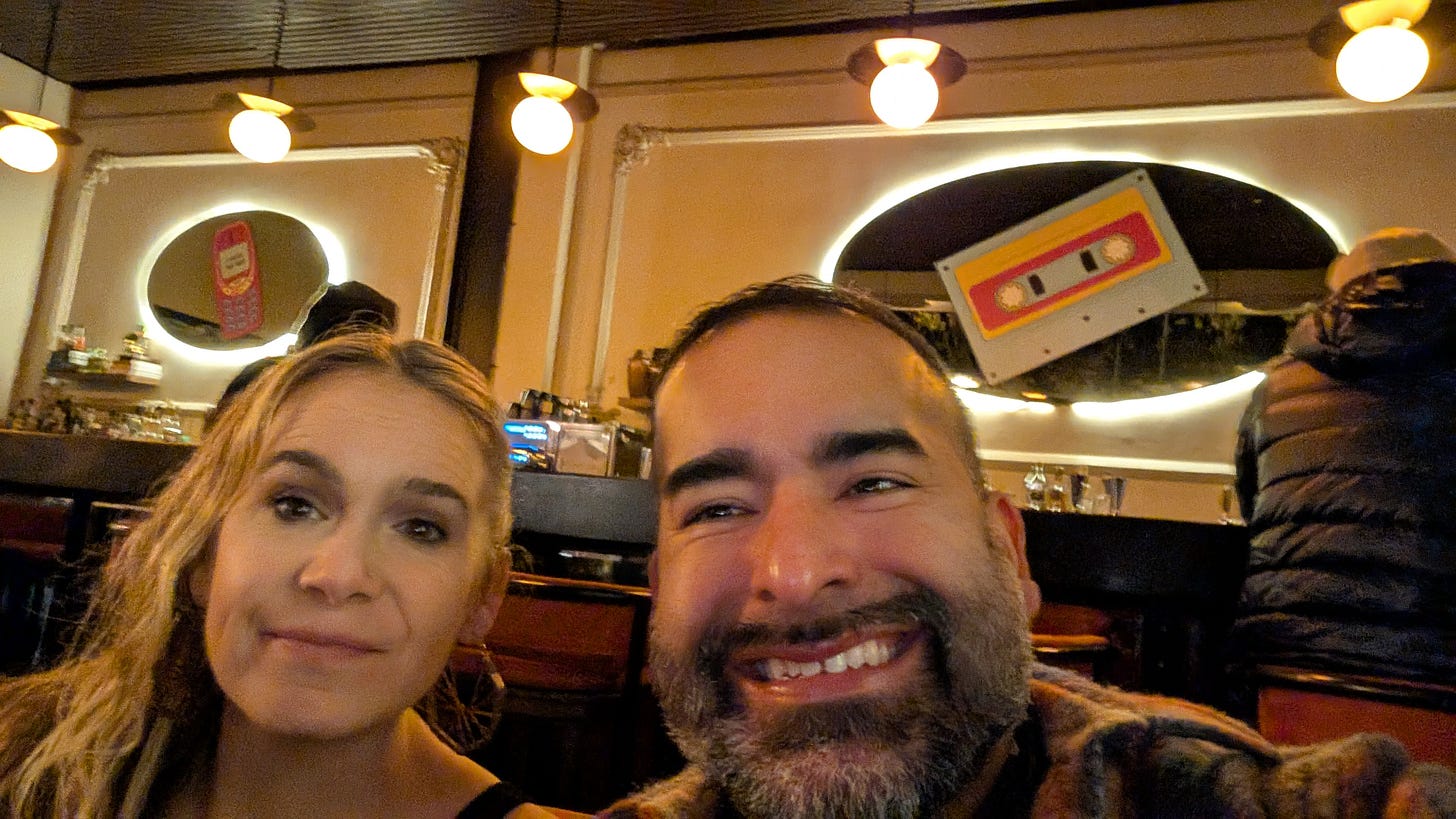
You’ll also understand just how hard it fought to get here. Against colonial bans. Against bureaucracy. Against being sidelined in favor of slicker exports. The fact that you can find mezcal today—from a backyard palenque to a shelf at your local shop—is a story of cultural tenacity. And taste.
But seriously: we covered a lot. From 8,000+ year-old agave farming to tequila’s glow-up, from volcanic soils to mezcal kisses, from biodiversity and politics to bubblegum-tasting booze. Mezcal is wild like that. And now? You can be too.
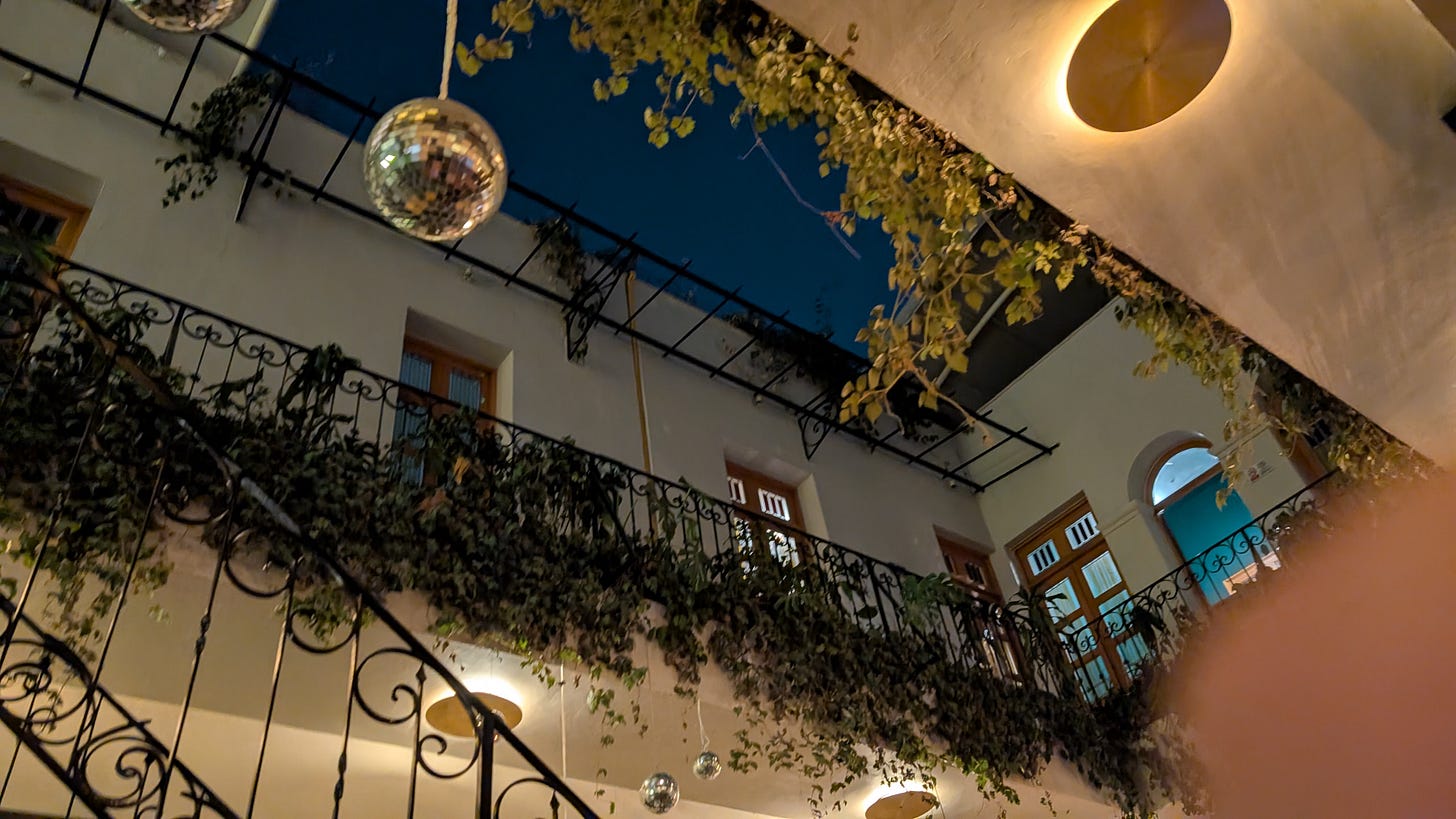
Whether you’re sipping mezcal in a vine-draped courtyard in Mexico City (Casa Prunes, IYKYK), or searching for a bottle of the good stuff in your corner of the world—slow down. Give it a kiss. Let it tell you its secrets.
If this story made you pause, smile, or rethink that house marg—or just glad people still make things this way—I’d love it if you dropped a comment, shared this with someone who still thinks mezcal is just smoky tequila, or hit that little subscribe so we can keep digging into the flavors (and questions) that bring people to the table.
And if you’re still with me: next week, we wrap up our Flavors of Mexico City Series with the best-kept secret we ate at. It’s hidden, it’s special, and it kind of sums up everything we love about Mexico City right now.And it’s kind of everything. You won’t want to miss it.
Until then, sip slow. Blame the conejos.
Salud to the good stuff—and the people who keep it weird, wonderful, and real.


